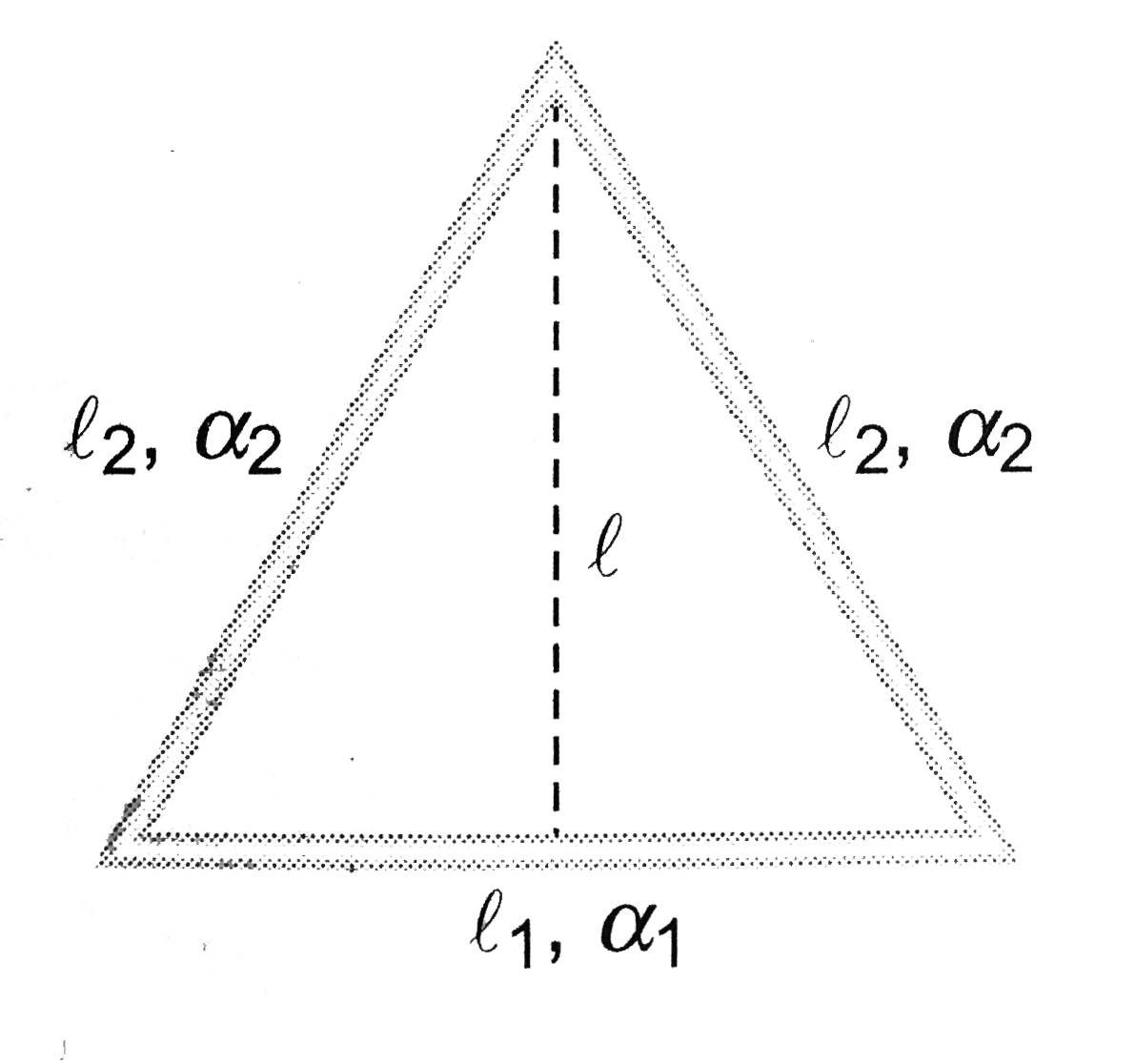Two rods, each of coefficient of linear expansion α2 and length l2, form the two sides of an isosceles triangle and the base is formed by another rod of length l1 and coefficient of linear expansion α1. The base is fixed horizontally at its mid-point. What should be the relationship between l1 and l2 so that the distance of the vertex from the mid-point of the base, does not change for any increase in temperature?
ABC is the isosceles triangle and D is the fixed point on the base [Fig. 5.8].
From the figure,
AD=√l22−(l12)2=x (say)
∴ x2=l22−(l12)2
Suppose with the rise in temperature by t, the length of AB and AC change to l.2,BC to l.I and AD to y.
∴ l.2=l2(1+α2t),l.1=l1(1+α1t)
∴ y2=l.22−(l.12)2={l2(l+a2t)}2−l21(1+α1t)24
≅l22(1+2α2t)−l21(1+2α1t4)
[neglecting higher powers of α1 and α2]
By condition, length AD should remain the same, i.e.
x2=y2
or, l22−l214=l22(1+2α2t)−14l21(1+2α1t)
or, 2l22α2t=12l21α1t
or, l22l21=14⋅α1α2 or, l2l1=12√α1α2.

Topper's Solved these Questions
- EXPANSION OF SOLIDS AND LIQUIDSBook:CHHAYA PUBLICATIONChapter:EXPANSION OF SOLIDS AND LIQUIDSExercise:SECTION RELATED QUESTIONS
Explore 6 Videos
- EXPANSION OF SOLIDS AND LIQUIDSBook:CHHAYA PUBLICATIONChapter:EXPANSION OF SOLIDS AND LIQUIDSExercise:HIGHGER ORDER THINKING SKILL (HOTS) QUESTIONS
Explore 31 Videos
- EXPANSION OF GASESBook:CHHAYA PUBLICATIONChapter:EXPANSION OF GASESExercise:CBSE Scanner
Explore 1 Video
- FIRST AND SECOND LAW OF THERMODYNAMICSBook:CHHAYA PUBLICATIONChapter:FIRST AND SECOND LAW OF THERMODYNAMICSExercise:CBSE SCANNER
Explore 18 Videos
Similar Questions
Two rods each of length L2 and coefficient of linear expansion α2 each are connected freely to a third rod of length L1 and coefficient of expansion α1 to form an isoscles triangle. The arrangement is supported on a knife-edge at the midpoint of L1 which is horizontal. what relation must exist between L1 and L2 so that the apex of the isoscles triangle is to remain at a constant height from the knife edge as the temperature changes ?
View SolutionTwo rods each of length L2 and coefficient of linear expansion α2 each are connected freely to a third rod of length L1 and coefficient of expansion α1 to form an isoscles triangle. The arrangement is supported on a knife-edge at the midpoint of L1 which is horizontal. what relation must exist between L1 and L2 so that the apex of the isoscles triangle is to remain at a constant height from the knife edge as the temperature changes ?
View Solution
Knowledge Check
An isosceles triangle is formed with a thin rod of length l1 and coefficient of linear expansion α1, as the base and two thin rods each of length l2 and coefficient of linear expansion α2 as the two sides. The distance between the apex and the midpoint of the base remain unchanged as the temperature is varied. the ratio of lengths l1l2 is
 A2√α1α2B√α2α1C2√α2α1D12√α2α1
A2√α1α2B√α2α1C2√α2α1D12√α2α1Two metal rods of lengths L1 and L2 and coefficients of linear expansion α1 and α2 respectively are welded together to make a composite rod of length (L1+L2) at 0∘C. Find the effective coefficient of linear expansion of the composite rod.
AL1α21−L2α22L21+L22BL21α1−L22α2L21+L22CL1α1+L2α2L1−L2DL1α1+L2α2L1+L2The coefficient of linear expansion of a rod is α and its length is L. The increase in temperature required to increase its legnth by 1% is
A1αB110αC150αD1100α
An isosceles triangles is formed with a thin rod of length l1 and coefficient of linear expansion α1, as the base and two thin rods each of length l2 and coefficient of linear expansion α2 as the two sides. The distance between the apex and the midpoint of the base remain unchanged as the temperature is varied. the ratio of lengths l1l2 is

View SolutionAn isosceles triangles is formed with a thin rod of length l1 and coefficient of linear expansion α1, as the base and two thin rods each of length l2 and coefficient of linear expansion α2 as the two sides. The distance between the apex and the midpoint of the base remain unchanged as the temperature is varied. the ratio of lengths l1l2 is

View SolutionAn isosceles triangles is formed with a thin rod of length l1 and coefficient of linear expansion α1, as the base and two thin rods each of length l2 and coefficient of linear expansion α2 as the two sides. The distance between the apex and the midpoint of the base remain unchanged as the temperature is varied. the ratio of lengths l1l2 is

View SolutionTwo rods of lengths l1andl2 are made of materials having coefficients of linear expansion α1andα2 respectively. What could be the relation between above values, if the difference in the lengths of the two rods does not depends on temperature variation?
View SolutionTwo rods of lengths l1andl2 are made of materials having coefficients of linear expansion α1andα2 respectively. What could be the relation between above values, if the difference in the lengths of the two rods does not depends on temperature variation?
View Solution
